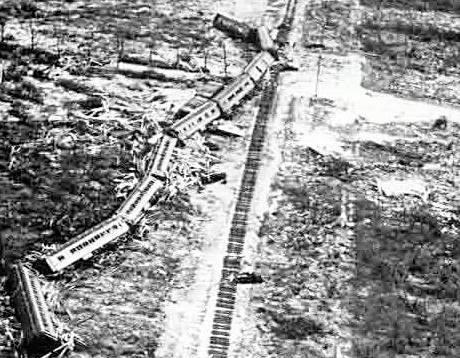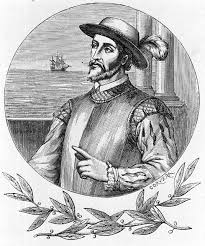As we begin yet another hurricane season, I thought I would write a post taking a look at the storms that have affected Southwest Florida over the past century.
1921 Storm with No Name
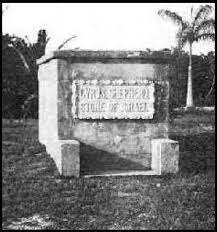
On October 17, 1921, a low pressure system was observed in the western Caribbean. By October 22, a Cat 1 hurricane with winds of 81 mph had formed. One day later, the storm intensified to a Cat 4 with winds up to 140 mph.
On October 24, the hurricane entered the Gulf of Mexico and made landfall near Tarpon Springs with 115 mph winds. Once again, Sanibel, Captiva, and Estero Islands were completely covered with water. In Punta Rassa, most of the homes were either washed away or suffered extensive damage. Many of the highways leading out of Fort Myers were impassible due to the high water. On Estero Island, buildings were destroyed or damaged, and the tomb of Dr. Cyrus Teed, the founder of the Koreshan Unity, was washed out to sea.
Great Miami Hurricane of 1926

On September 17, 1926, tropical storm force winds began to blow in Lee County. The east coast of the state went under a storm watch at noon on the 17th and by 11 PM, the storm watch became a hurricane warning. Seven hours later, the storm made landfall in Miami as a Cat 4. After crossing the state, the storm exited the southwest coast near Bonita Springs with the eye of the storm passing over Punta Rassa. The storm surge was four to six feet above normal, flooding Sanibel with salt water and forcing half the residents to relocate. According to the Naples Star, cars that were parked on the streets were, “filled with muddy saltwater and sea creatures. Those animals later died when the water subsided leaving a stench that lingered for weeks.”
The storm surge in Miami was 14 feet with 150 mph winds. Over 373 people died as a result of the 1926 storm.
Lake O Hurricane of 1928
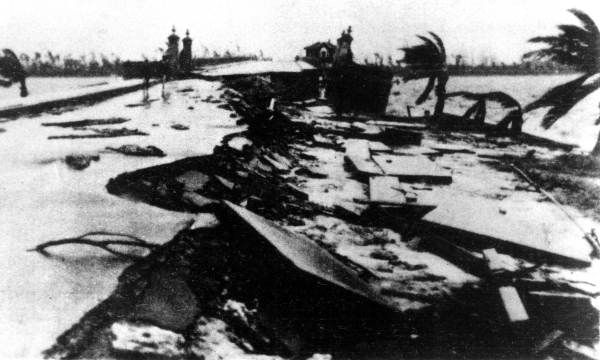
One of the deadliest hurricanes in history, the Okeechobee hurricane of 1928, killed approximately 2,500 people in the US, most around Lake O. The storm developed off the west coast of Africa on September 6 as a tropical depression. Forty eight hours later, a Cat 1 hurricane was tracking westward, reaching Cat 4 intensity before striking Guadeloupe on September 12. One day later, the storm became a Cat 5 with winds of 160 mph and struck Puerto Rico where 24, 728 homes were destroyed and 193, 444 were damaged leaving a half million people homeless.
The storm then emerged into the Atlantic as a Cat 4 crossing through the Bahamas and making landfall near West Palm Beach on September 17 with 145 mph winds. The storm surge caused water to pour out of Lake Okeechobee flooding the surrounding areas with 20 feet of water destroying everything in its path and causing at least 2500 people to drown. Damage was estimated at 25 million.
Labor Day Hurricane of 1935
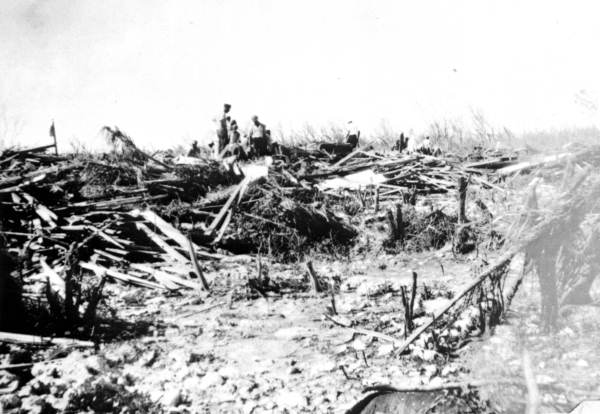
The second major hurricane of the 1935 season, the Labor Day Hurricane caused catastrophic damage in the Florida Keys with a storm surge of 18-20 feet. The Cat 5 winds destroyed nearly all structures between Marathon and Tavernier. The town of Islamorada was obliterated and portions of the Key West Extension of the Florida East Coast Railway were damaged or destroyed.
The compact and intense hurricane caused catastrophic damage in the upper Florida Keys, as a storm surge of approximately 18 to 20 feet (5.5 to 6.1 m) swept over the low-lying islands. The hurricane’s strong winds and the surge destroyed nearly all the structures between Tavernier and Marathon. The town of Islamorada was obliterated. Portions of the Key West Extension of the Florida East Coast Railway were severely damaged or destroyed. In addition, hundreds of World War I veterans who had been sent to the Keys to build the Overseas Railroad were killed. The storm surge floated an entire train into the ocean.
Sanibel Hurricane of 1944

On October 12, 1944, a disturbance in the western Caribbean rapidly strengthened into a tropical storm. Within 24 hours, the storm grew into a hurricane which later became known as the 1944 Cuba-Florida hurricane, the 1944 San Lucas hurricane, and the Sanibel Island Hurricane of 1944. On October 16, the storm made landfall in Western Cuba as a Cat 4 hurricane causing extensive damage and killing 300 people.
The storm crossed the Dry Tortugas as a major hurricane on October 18 before making its final landfall near Sarasota as a Cat 2 hurricane.
On Estero Island at least 15 cottages were destroyed as well as the island fishing pier. The entire island was under 3-6 feet of seawater, flooding buildings and ruining crops. The storm surge reached as far as downtown Fort Myers flooding roads with 3-5 feet of water.
Hurricane Donna-1960

Hurricane Donna formed south of Cape Verde on August 29, 1960. The system became a tropical storm the next day and reached hurricane status on September 1. By September 6, Donna had sustained winds of 145 mph when it made landfall on the Keys. The storm then skirted the west coast and made a second landfall south of Naples with 120 mph winds. The storm surge was 4-7 feet covering much of the Fort Myers Beach with water. The wind gusts were up to 121 mph with gusts of 100 mph felt as far north as Sarasota. Donna was the 9th costliest storm with damages estimated at 6.6 billion. Direct deaths from the storm are estimated at 364. For more information and a first hand account of surviving Donna, visit buntingsbeachblog.com.
Hurricane Andrew-1992

Hurricane Andrew was born off the west coast of Africa on August 14, 1992 and became a tropical storm on August 17. The storm developed slowly and almost died on August 20 due to severe wind shear. The next day, Andrew was located between Bermuda and Puerto Rico. A westward turn brought the storm into the warmer waters and a more favorable environment for development. Once Andrew got into this area, it strengthened rapidly reaching Cat 4 status on August 23. On August 24, Andrew came ashore near Homestead as a Cat 5 with winds over 170 mph. Over 1.4 million people lost power which was out for more than a month in some places. 70,000 acres of trees were destroyed in the Everglades. In Florida, Andrew killed 44 and left $25 billion in damages.
Hurricane Charley-2004

2004 was the year of the hurricane in Southwest Florida. Hurricane Charley was the first of four storms to impact Florida in 2004 along with Frances, Ivan, and Jeanne. Charley, however, had the largest impact on Southwest Florida. Charley was the third named storm of the season and became one of the strongest hurricanes to ever strike the US.
Charley lasted from August 9 to 15, and at its peak intensity it attained 150 mph (240 km/h) winds, making it a strong Category 4 hurricane on the Saffir–Simpson scale. It made landfall in Southwest Florida at maximum strength, making it the strongest hurricane to hit the United States since Hurricane Andrew struck Florida in 1992 and the strongest hurricane to hit southwest Florida in recorded history. Charley moved slowly through the Caribbean, crossing Cuba on August 13 as a Cat 3 storm. With winds up to 150 mph, Charley came ashore on the northern tip of Captiva before moving inland to Bokeelia and curving northeast devasting Punta Gorda, Port Charlotte, Arcadia, Sebring, and Wauchula. The storm passed through Central Florida with winds up to 106 mph before exiting the state just north of Daytona Beach.
Charley caused 10 deaths and $16.9 billion in damage, making it the second costliest hurricane in the United States history at the time. Although it was very strong, Charley was a compact, fast-moving storm which helped to limit the scope and severity of the damage.
Hurricane Wilma-2005
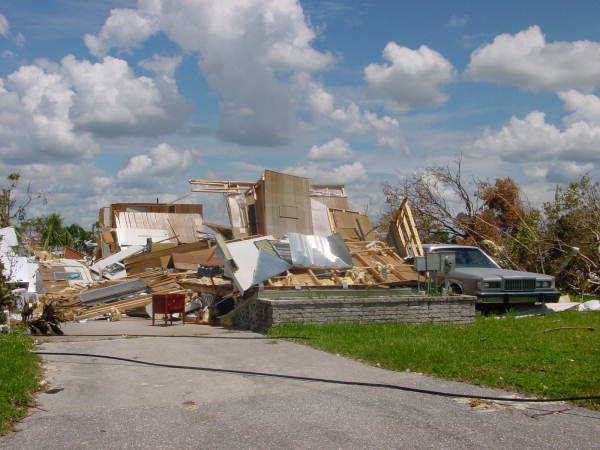
The 2005 hurricane season included three of the ten most intense Atlantic hurricanes to ever hit the US. It also holds the record as the most intense tropical cyclone ever recorded in the Atlantic basin. Wilma was the twenty second storm of the season. It was the sixth major hurricane, the fourth Cat 5 hurricane, and the second most destructive hurricane of the season (Rita was #4 and Katrina #5).
Wilma started as a tropical depression in the Caribbean on October 15, became a tropical storm on October 17 when it made an abrupt southwest turn and continued to strengthen, becoming a hurricane on October 18. In the next 24 hours, Wilma exploded into a Cat 5 storm with winds of 185 mph.
Wilma made landfall near Cape Romano with winds of 120 mph. At least 52 deaths were recorded and damages totaled $22.4 billion.
Hurricane Irma 2017

Hurricane Irma was the first Cat 5 storm of the 2017 season, and at the time, it was considered the most powerful hurricane on record in the open Atlantic region. It was the third strongest Atlantic hurricane at landfall just behind the 1935 Labor Day Hurricane.
Irma was born out of a tropical wave near the Cape Verde Islands on August 30, 2017. One day later, Irma was a Cat 3 hurricane, and by September 4, Irma was a Cat 5 with sustained winds of 180 mph. Irma briefly weakened to a Cat 2 after making landfall in Cuba, but re-intensified to a Cat 4 when it made its way into the Florida Straits before coming ashore near Cudjoe Key on September 10. The storm weakened to a Cat 3 prior to making a second landfall on Marco Island later that day.
